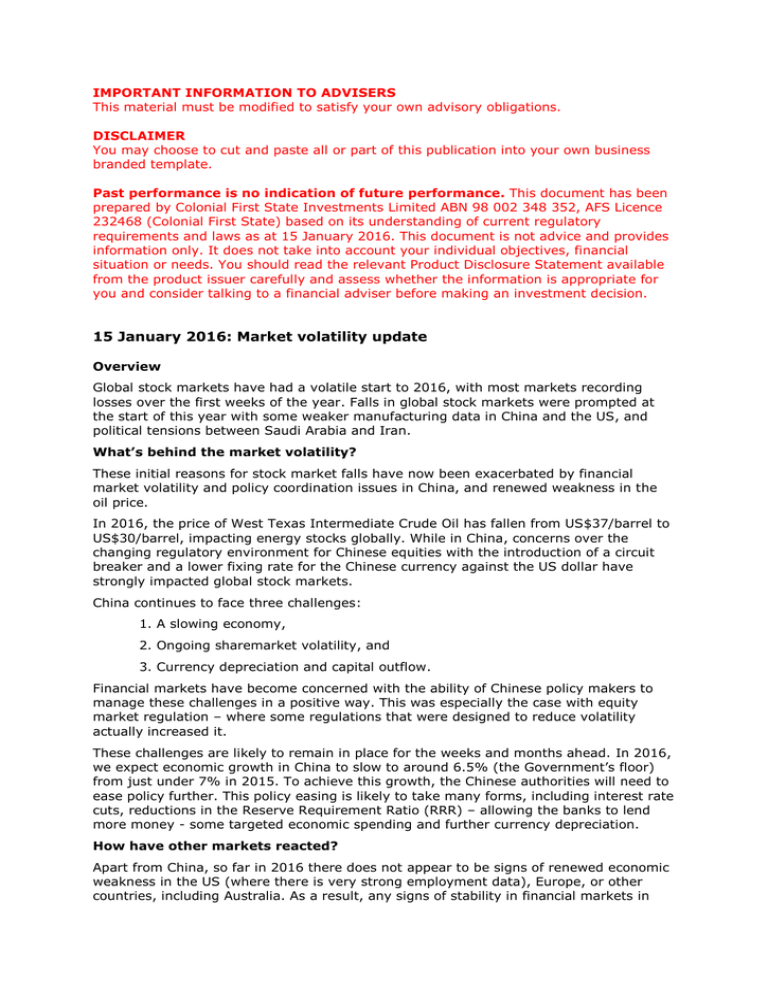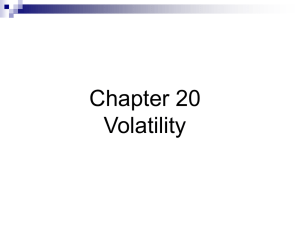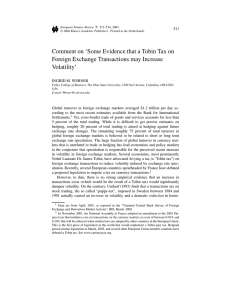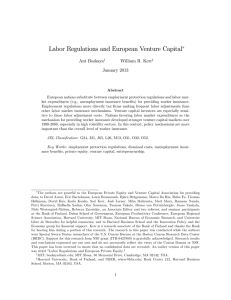Market volatility update - 15 January 2016
advertisement

IMPORTANT INFORMATION TO ADVISERS This material must be modified to satisfy your own advisory obligations. DISCLAIMER You may choose to cut and paste all or part of this publication into your own business branded template. Past performance is no indication of future performance. This document has been prepared by Colonial First State Investments Limited ABN 98 002 348 352, AFS Licence 232468 (Colonial First State) based on its understanding of current regulatory requirements and laws as at 15 January 2016. This document is not advice and provides information only. It does not take into account your individual objectives, financial situation or needs. You should read the relevant Product Disclosure Statement available from the product issuer carefully and assess whether the information is appropriate for you and consider talking to a financial adviser before making an investment decision. 15 January 2016: Market volatility update Overview Global stock markets have had a volatile start to 2016, with most markets recording losses over the first weeks of the year. Falls in global stock markets were prompted at the start of this year with some weaker manufacturing data in China and the US, and political tensions between Saudi Arabia and Iran. What’s behind the market volatility? These initial reasons for stock market falls have now been exacerbated by financial market volatility and policy coordination issues in China, and renewed weakness in the oil price. In 2016, the price of West Texas Intermediate Crude Oil has fallen from US$37/barrel to US$30/barrel, impacting energy stocks globally. While in China, concerns over the changing regulatory environment for Chinese equities with the introduction of a circuit breaker and a lower fixing rate for the Chinese currency against the US dollar have strongly impacted global stock markets. China continues to face three challenges: 1. A slowing economy, 2. Ongoing sharemarket volatility, and 3. Currency depreciation and capital outflow. Financial markets have become concerned with the ability of Chinese policy makers to manage these challenges in a positive way. This was especially the case with equity market regulation – where some regulations that were designed to reduce volatility actually increased it. These challenges are likely to remain in place for the weeks and months ahead. In 2016, we expect economic growth in China to slow to around 6.5% (the Government’s floor) from just under 7% in 2015. To achieve this growth, the Chinese authorities will need to ease policy further. This policy easing is likely to take many forms, including interest rate cuts, reductions in the Reserve Requirement Ratio (RRR) – allowing the banks to lend more money - some targeted economic spending and further currency depreciation. How have other markets reacted? Apart from China, so far in 2016 there does not appear to be signs of renewed economic weakness in the US (where there is very strong employment data), Europe, or other countries, including Australia. As a result, any signs of stability in financial markets in China - and a more effective policy response - should see global markets stabilise somewhat and begin to focus more on economic fundamentals rather than concerns over China-specific events. Markets are likely to continue to trade with volatility in 2016 with further interest rate rises expected in the US following the historical first hike in December 2015, versus policy easing elsewhere leading to central bank divergence for the first time since the Global Financial Crisis (GFC). What does the market volatility mean for your investments? Accumulators: It’s time in the market, not timing the market, that’s important. So if you can ride out the volatile times, you could have a smoother return over the long term. Diversifying your investments can help to defend against volatility and reduce risks. You can diversify across a variety of investment options. It’s also important to manage your expectations. A slower global economic growth rate means a period of lower returns on traditional asset classes. Returns in the decade leading up to the recent GFC were abnormally high, so it’s important you don’t use these returns as the norm. It’s also a good idea to be aware of your own tolerance to risk so that you can assess new investment opportunities as they arise. So don’t be discouraged when you hear the word "volatile". Talk to your financial advisor today, to see what type of action best suits your investment plan. Pre- and post-retirees: If you’re in retirement or nearing retirement, it is understandable you want to protect your investments. After all, your investment returns play a vital role in funding your retirement. In times of volatility it’s easy to react emotionally. But now is the time to keep a level head and stick to your long term investment strategy. Trying to time the markets and responding to every market movement could leave you considerably worse off. It’s a good time to speak to your financial adviser and remind yourself that markets do recover. Don’t let short-term volatility get in the way of your longer-term needs.



![[These nine clues] are noteworthy not so much because they foretell](http://s3.studylib.net/store/data/007474937_1-e53aa8c533cc905a5dc2eeb5aef2d7bb-300x300.png)





